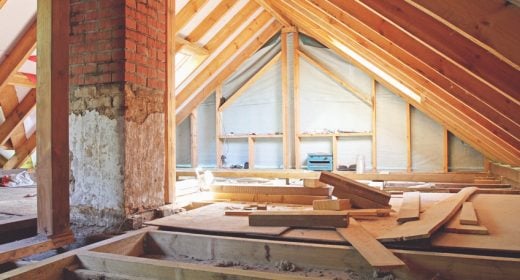
Converting your empty loft space into a useable room can be the most cost effective way of adding significant value to your home and increasing your livable space - whether for another bedroom, office, gym or entertainment room for your teenagers. But where should you start and what do you need to consider?
Why do a loft conversion?
A loft conversion can add a significant amount of money – up to 20% – to the value of a property. Many families choose to convert their loft area as a means of obtaining more space without having to endure the costly and stressful process of moving home. Work taking place in the loft can also be less disruptive than, say, a major extension to an existing living space.
Is my loft a useable space?
You’ll want to start by assessing whether your roof space is suitable for conversion.
We went to the Federation of Master Builders for their view. Duncan Binnie, of John Duncan Ltd, a loft specialist, and FMB member said “Most lofts can be converted, but there are three main things you need to check to be sure. The first and most important is the internal height of the existing loft, from the top of the ceiling joist to underneath the ridge board in the apex.”
Take a measurement from the bottom of the ridge timber to the top of the ceiling joist. You may find you can get a useful room with as little as 2.2m in the useable part of the roof. But Duncan Binnie couldn’t disagree more, “This measurement is critical and needs to be 2,500mm to suitably convert.”
Duncan continues, “The second consideration is the pitch of the roof. In general, the pitch is fine from 30 degrees plus.” The higher the pitch angle, the higher the central head height is likely to be.
“The third thing to consider is the footprint of the existing loft space. As a minimum rule of thumb, internal walls should measure 5,500mm side to side inclusive of the chimney and 7,500mm front to back. If you are in and around the above as a minimum then you should be able to convert,” says Duncan.
How will I use the space?
Once you have roughly established your home is suitable for a loft conversation, think about how you would like to use it; perhaps an extra bedroom with en-suite bathroom, or maybe a den or playroom for your growing children. How about a space to relax or study?
Or it could be a multi- purpose room with a combination of uses, such as extra living space which doubles as guest accommodation. If you are going to include a bathroom, will it be a shower room or will there be space to include a bath? When you are thinking about planning a bathroom in a loft, remember to leave plenty of headroom.
Also think about storage, as built-in space can often be included, especially in the eaves.
Can I convert the loft myself?
The installation of a loft conversion is a complicated process, which may involve your planning department and certainly require Building Regulations sign off (see below).
Whilst it is possible to attempt a DIY conversion, with expert help for some of the trickier aspects, the large amount of work involved often results in many people choosing to contract a specialist loft conversion company to undertake the task.
Who should I use to do my loft conversion?
There are a few options:
1. Appoint an architect/technician or building surveyor. They will prepare drawings and designs for your proposal, obtain the necessary Approvals and if required they will also help you find a suitable builder and manage the project for you.
2. Appoint a specialist loft conversion company. These companies offer a one-stop shop for loft conversions: their design department will prepare the necessary drawings and obtain the necessary approvals and their construction departments will translate the designs into reality.
3. Use an experienced builder. Some builders have experience of loft conversions and may well be able to offer you a package similar to the loft conversion companies.
Ask neighbours, friends or search online to find a trusted architect, loft conversion company or experienced builder for your project. Don’t forget to get three quotes and make sure they visit the site and quote based on accurate measurements. Knowing how you want to use the space will be essential to getting a few good quotations.
Do I need planning permission and building regulations?
Planning permission is not normally required unless you are extending the roof space or exceed specified limits e.g. any dormer is higher than the current highest part of the roof or you live within a conservation area. It’s best to check with your local planning department to understand what you are allowed to do.
Building regulations apply to loft conversions to ensure, for example, that the structural strength of the new floor is sufficient, the stability of the existing structure is not endangered, there are safely designed stairs to the new floor and reasonable sound insulation exists between the conversion and the rooms below. There are also fire safety regulations with which you may need to comply.